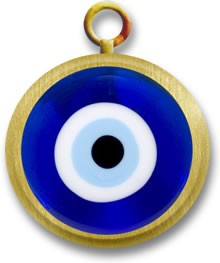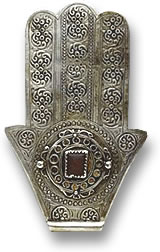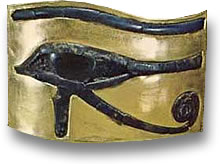|
Reviewed By Andreas Zabczyk
Protective Eye Amulets
Turkish Gold Nazar Pendant
Eye amulets that are believed to provide protection are popular in various countries and cultures. Some such amulets can be hand-shaped with an eye or another symbol in the centre. They can be in the form of a natural looking hand, or a symmetrical hand with two thumbs. Eye amulets can be made from silver, gold or other metal, with filigree, inlay or gemstones such as amber, coral, turquoise and lapis lazuli. Some of these talismans are believed to protect the wearer and others are said to reflect the evil eye back on the one bestowing it. The evil eye is injury or bad luck that is inflicted upon a person by a powerful look or gaze. The curse of the evil eye is usually thought to be a result of intentional malevolence, but is also said to happen unintentionally. Amulets to protect against the evil eye are given a different name depending on the region. In some countries they are called "khamsa". In Islam, "khamsa" means "five" and represents the hand of Fatima. Fatima was the daughter of Mohammed. Others say the number five represents the five pillars of Islam, which are the five obligations of Muslims; testimony, prayer, concern for the needy, self-purification and the pilgrimage. The number five of the hamsa is also said to be the Five People of the Cloak; who are the prophet Mohammed and his family. Some Muslims see evil eye amulets as sinful or superstitious. 
Silver and Gemstone Khamsa Amulet
In Judaism, evil eye amulets are known as "hamsa" or "the hand of Miriam", who was Moses's sister. The word, "hamsa" comes from the Hebrew word, "hamesh", meaning "five". Some say this refers to the five fingers of the hand, and others believe that the number refers to the books of the Torah. In Judaic hamsas, symbols such as fish or the Star of David can be seen, and also red and blue colors, which are thought to keep away the evil eye. Hamsas are sometimes displayed on walls as well as worn as amulets. These amulets are also popular in pagan culture and folklore. It is thought that they were used by ancients in the eastern Mediterranean region, before the development of modern world religions. Some people wear evil eye amulets simply as decorations, since they make interesting jewelry items. Modern hand-shaped pendants are sometimes studded with colored gemstones. These amulets are also popular souvenirs bought by tourists visiting places such as Turkey. In Turkey, evil eye amulets are known as "nazar". Nazar are usually eye-shaped rather than hand-shaped. The eye is typically blue on a white or yellow background with a black pupil in the center. They are often made from colored glass and sold as pendants, bracelets, beads, rings and other trinkets. 
Eye of Horus Lapis Lazuli in Gold
In ancient Egypt, the Eye of Horus represented protection. Horus was an ancient Egyptian sky god who had the head of a falcon. In ancient Egyptian mythology, Horus lost an eye during a fight to protect the throne. Horus' eye was restored and thus seen as a symbol of restoration and protection. This symbol was incorporated into ancient Egyptian jewelry made with materials such as gold, silver, lapis lazuli and carnelian. Amulets that were placed on mummies often took the shape of the Eye of Horus and eyes were painted onto tombs and also boats. These eyes were considered "all seeing" and thereby offered magical protection for the living and the dead. Whatever the beliefs of the wearer, name they are given or origin of eye amulets, these beautiful and interesting items are thought to be protective for all and to bring their owners success. As they say, beauty is in the eye of the beholder. This Page in Other Languages
|
| STAY IN TOUCH | NEWSLETTER |
| *You're signing up to receive GemSelect promotional email. |
Copyright © 2005-2024 GemSelect.com all rights reserved.
Reproduction (text or graphics) without the express written consent of GemSelect.com (SETT Company Ltd.) is strictly prohibited.
2541